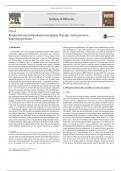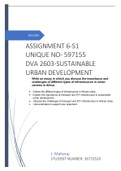Epilepsy & Behavior 34 (2014) 25–28
Contents lists available at ScienceDirect
Epilepsy & Behavior
journal homepage: www.elsevier.com/locate/yebeh
Editorial
Responsive neurostimulation in epilepsy therapy: Some answers,
lingering questions☆
1. Introduction following device implantation. The subjects were randomized to sham
(no stimulation, n = 94) and treatment (n = 97) groups one month
In November 2013, the Food and Drug Administration (FDA) granted after the implant. Following randomization, the subjects assigned to
a premarket approval for the RNS System (NeuroPace, Inc.) of closed- the treatment group began stimulation therapy. Stimulus parameters
loop, responsive stimulation for the treatment of drug-resistant focal were adjusted weekly during a four-week optimization period (OP)
epilepsy. The decision followed a favorable vote by the FDA's Neurolog- based on self-reported seizure recurrence, occurrence of side effects to
ical Devices Panel, an advisory board one of the authors (JEC) was a stimulation, and review of the electrocorticogram (ECOG) stored by
member of, in February 2013 [1]. The RNS System was designed to de- the RNS System. Because of implant constraints, ECOG was not recorded
tect focal electrographic seizures in selected brain regions sampled continuously. The ECOG epochs stored for review included detections
with intracranial electrodes and respond by delivering electrical stimu- of abnormal electrical activity representing presumed ictal discharges,
lation to those regions aimed at terminating the seizures [2]. The panel's responsive stimulation treatment bursts and their effects on the elec-
endorsement of the device was primarily based on recently published trographic ictus, and stimulation-related afterdischarges. A 12-week
results [3] and updates [1] from the RNS Pivotal Study, a multicenter, blinded evaluation period (BEP) followed, during which the treatment
prospective, randomized, double-blind, sham stimulation-controlled group continued to receive responsive stimulation, and the sham
trial, which assessed the safety and efficacy of the RNS System as group did not. All subjects were assessed in monthly clinic visits, and
adjunctive therapy of seizures from ≤ 2 seizure foci in adults with their seizures were logged on a daily basis. All subjects, whether assigned
focal epilepsy that had failed to improve with ≥2 antiepileptic drug tri- to treatment or sham, were then able to receive stimulation during an
als. During the study, 191 patients with an average of ≥3 disabling sim- 84-week open-label period (OLP) [3].
ple partial, complex partial, or secondarily generalized seizures/month
over a 12-week baseline period (BP) had the stimulator implanted. 2. RNS System clinical safety and efficacy: results and analysis
These were patients with severe forms of epilepsy: 32% had failed ther-
apeutic epilepsy surgery, 34% had been implanted with a vagal nerve 2.1. Safety
stimulator (VNS, which was removed prior to implanted with a), 59%
had undergone intracranial monitoring, 55% had two seizure foci, and The study met its primary safety endpoint, which required that the
50% had mesial temporal lobe epilepsy, of whom 73% had bitemporal rate of serious adverse effects (SAEs) not exceed the prespecified SAE
epilepsy. The RNS System placement required a craniectomy. The device rate of historical comparators for the first four (seizure-related acute
was connected to one or two of up to four intracranial quadripolar elec- implantation of intracranial electrodes and epilepsy resective surgery)
trode leads consisting of subdural strips, no more than two depth elec- and 12 weeks (deep brain stimulation for treatment of movement dis-
trodes, or a combination of depth and subdural electrodes localized to orders) after the implant [1]. There was no statistically significant differ-
1–2 epileptogenic region(s) previously defined by standard presurgical ence in SAEs between the treatment and sham groups during combined
evaluation [3]. The RNS System was equipped with three computation- OP and BEP. There was also no difference in mood and neuropsycholog-
ally efficient algorithms (half-wave, line length, and area) for early sei- ical status. The most nonserious adverse effects were implant site pain
zure detection; two individual detectors could be configured for any and headache. When all patients enrolled in RNS System trials (Feasibil-
two electrode channels [2]. After detection, one to five stimulation ther- ity, Pivotal, and Long-term Treatment studies) were pooled (n = 256),
apies, each consisting of two independently programmable bursts, there were a total of seven deaths due to SUDEP, which reflects a rate
could be delivered sequentially according to several electrode configu- below the corresponding prespecified comparator (9.3/1000 patient-
rations dictated by the spread of the seizure onset. All enrolled patients years). One death was due to status epilepticus (SE). Overall, in the
could undergo modification of the seizure detection parameters pooled population, implant site infection was reported in 6.3% of the pa-
tients, premature battery depletion in 4.3%, medical device removal in
4.3%, intracranial hemorrhage not related to seizures in 2.7%, device
☆ Submission declaration: The work described has not been published previously and is lead damage in 3.1%, and revision in 2.7% [1]. There were no study with-
not under consideration for publication elsewhere. The publication is approved by all au- drawals because of an adverse effect related to a change in seizures. Se-
thors, and it will not be published elsewhere, including electronically in the same form, in rious adverse effects due to increased seizure frequency or severity or a
English, or in any other language without the written consent of the copyright holder.
The views are solely those of the authors and not reflecting the views of the University of
new seizure type occurred in 16% of the patients. Episodes of SE oc-
Texas or the Veterans Administration. The copyright of this manuscript cannot be trans- curred in 3.9% of the subjects, with three episodes considered related
ferred to the publisher as US laws require this to be in the public domain. to the device. One patient experienced nine SE episodes. The rate of
http://dx.doi.org/10.1016/j.yebeh.2014.02.014
1525-5050/Published by Elsevier Inc.





